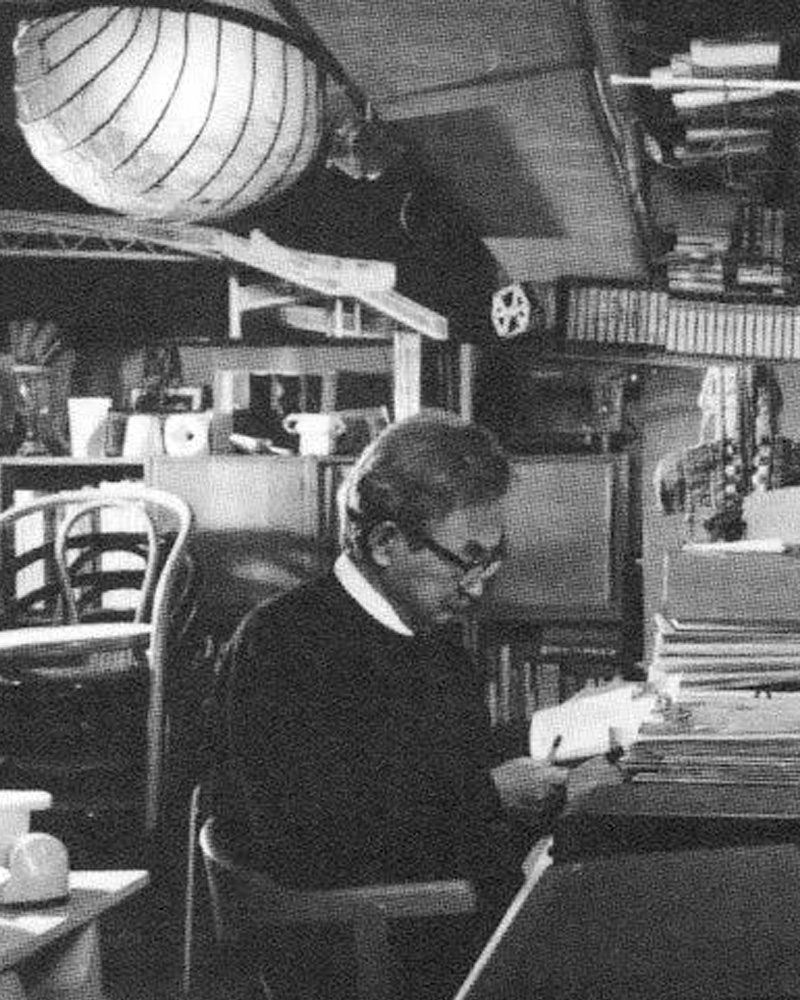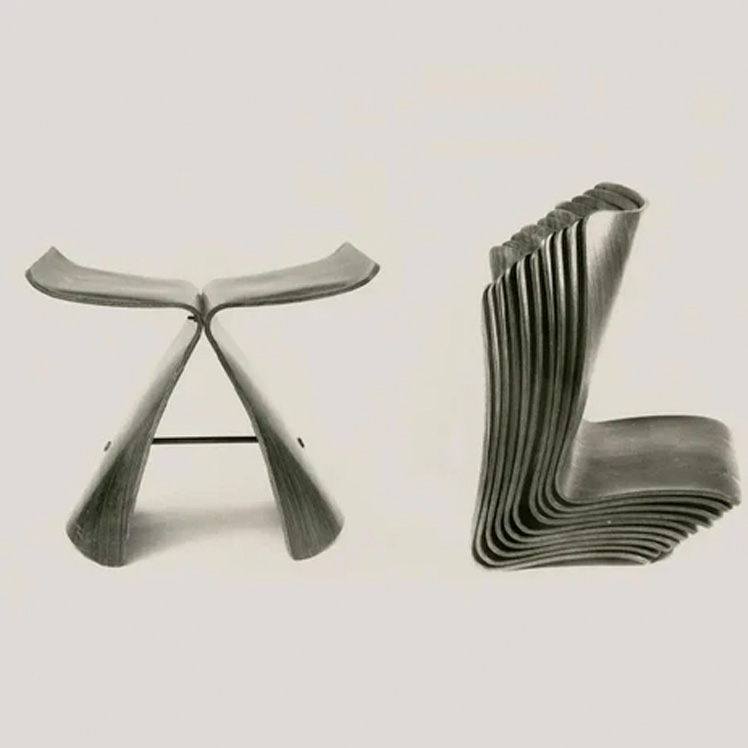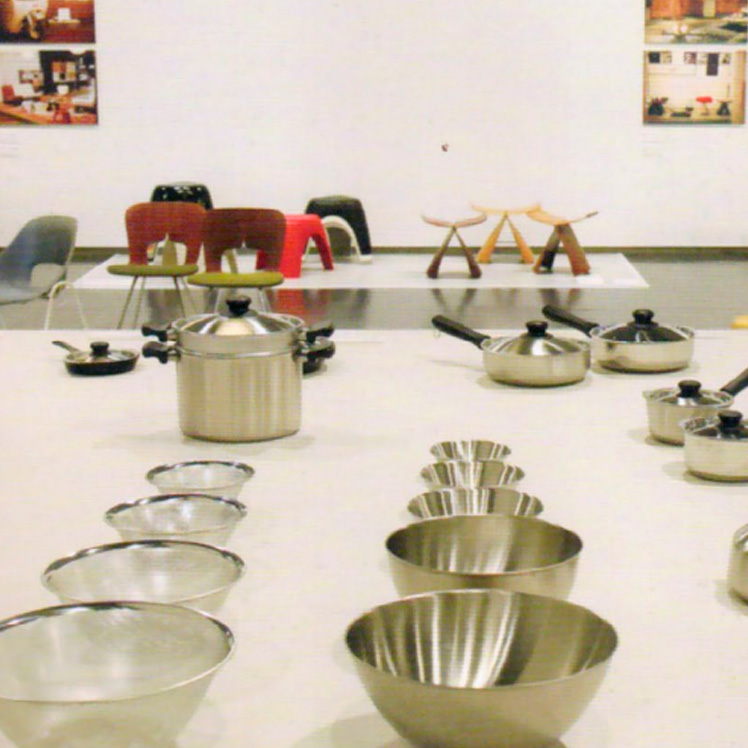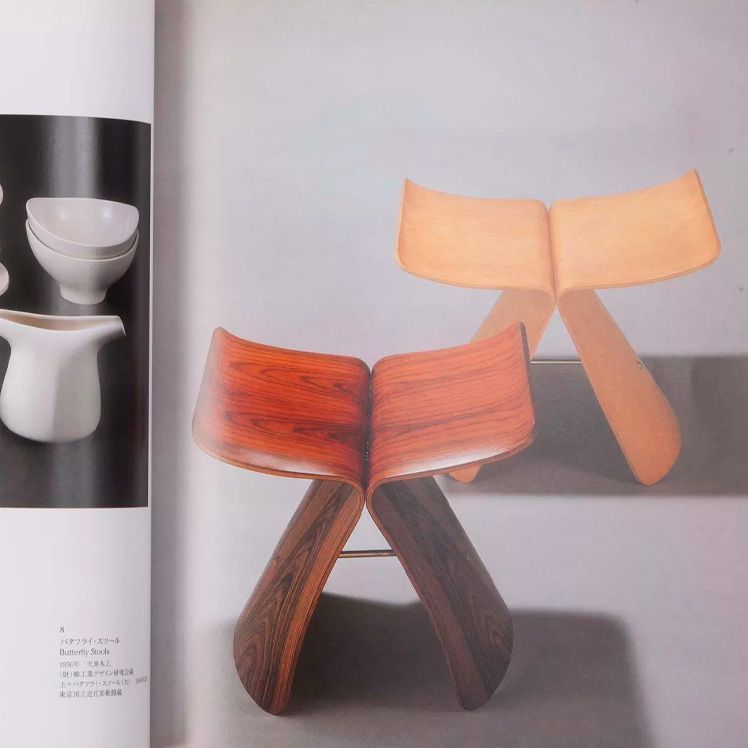Side Gallery
Side Gallery
WishlistFollow
Follow

Yanagi Sori 柳 宗理 was the first born of Yanagi Soetsu, father, philoso pher, and the founder of "Mingei Undou (folk craft movement)", and Kaneko, mother and vocalist.
Yanagi Sori started out at the Arts School (currently Tokyo National University of Fine Arts and Music) as an oil painting major- a field that is completely different from design. I suspect that Yanagi first realized he had an interest in design when he worked as an interpreter for Charlotte Perriand. Perriand was invited to visit Japan by the Ministry of Business and Industry. While he was working for Toyo Kaikan in Manila, Philippines, he became more internationalized through his experiences with the rich and materialistic lifestyle of the U.S. He experienced Japan's loss of World War II while he was abroad. He had to run for his life through the jungle in order to escape. This experience had a significant impact on the rest of his life.
His independence and his strong desire to maintain his own sense of style shows that he intends to remain a freelance industrial design- er for the rest of his life.
In 1952. Yanagi won first prize at the 1st New Industrial Design Competition hosted by Mainichi Shinbun. At that time, the prize was 1 million Japanese yen, which is now equivalent to about 20 million yen. Yanagi donated part of the prize money to a newly formed asso ciation called the Industrial Designer's Association in Japan and used the rest of it to found The Yanagi Industrial Design Research Foundation. In our industry, foundations are rare. Yet that was how this unique foundation got its start.
Yanagi likes to design his products on a real-life scale. Instead of drawing his designs on paper, he begins with a three dimensional model. He uses clay or styrofoam to actually sculpt the design by hand, producing a design which fits perfectly to the body. This is why he has created such beautiful masterpieces like the Elephant Stool and the Butterfly stool. These cannot be created out of drawings made on paper. Yanagi not only designs his furniture in this way, but also cutlery and tableware. His technique is different from ordinary industrial designers, but the foundations of his design are full of his own originality.
Yanagi doesn't only take orders from manufacturers to design products. He actively creates products that he thinks are good and later finds a manufacturer who will agree to produce them. Many of his masterpieces were created in this way. Any freelance designer should learn this lesson from him.
There was a time when all daily use tableware was painted with a pattern or a picture. One time, Yanagi introduced a plain ceramic design to a wholesaler. The wholesaler took a look at the design and seriously asked Yanagi, "What are you going to pain on this?"
Nowadays, many wholesalers will accept that the function and beauty of a design is more valuable than what is printed on it. Yet this story took place at a time when tableware without a printed design was thought of as a half-finished product. Yanagi has been fighting to make the point clear that design is important in and of itself.
Yanagi has produced many long-time sellers. Even if a product has gone out of production, it has been reissued due to strong feedback and support from consumers. Even though 50 years have passed since his products first came out, they still look new. This may be because Yanagi always designs a product from the customer's point of view.
Yanagis designs cover a wide variety of areas. He has designed solid objects such as furniture, cutlery, cooking equipment and table ware, as well as graphic design, architecture (bridges), and the design of an Olympic torch stand.
In addition to his designs, he became curator of the Japan Folk Craft Museum in 1977. The Japanese folk movement " MINGEI" was started by his father. Yanagi Soetsu who was a philosopher. The movement is based on the belief that any product produced by the people, which aspires to be of utmost use, will result in a unique kind of beauty.
When Yanagi was young, he rebelled against his father and decid. ed to pursue a separate path. However, as he learned more about modern design, he found many similarities between them. He con- cludes as follows:
1 Functionism the beauty of use. As the function and usage of a product become refined, it will start to show its beauty.
2 A product should be designed according to the characteristics of the materials used.
3 Proper use of technique. Just as there is craftsmanship, there should be "Productsmanship".
4 Repeated production. Folk Craft refers to it as "the repeated use of hands on job is necessary for the acquisition of sureness".
5 Mass production to reduce costs.
He decided to move into the world of oil painting, because he was rebellious against his father. He even chose pure art, which his father had totally ignored. However, Yanagi was introduced to the work of Le Corbusier through Mizutani Takehiko, who had just returned to Japan after studying at Bauhaus. Yanagi decided to study French because he wanted to read a book written by Le Corbusier called "La Ville Radieuse". His French language skills came to his advantage when he was appointed as an interpreter to Charlotte Perriand. Perriand was invited by The Department of Trade at The Ministry of Business and Industry, as an advisor for exporting crafts. Ms. Perriand worked in interior and furniture design; she was a partner of the French architect, Le Corbusier, at that time.
Though Soetsu did not want his children to be the successors of his work, fifteen years after he died, Yanagi became curator of The Japanese Folk Craft Museum. No matter how hard Yanagi tried to reject his upbringing, he could not deny the fact that he had been raised with masterpieces which were carefully selected by his father. Soetsu.
Through the work of the Japanese Folk Craft Movement he has rediscovered the importance of anonymous design, which has forced him to answer the question of what the true meaning of design is.
CHAIRS
Butterfly Stool
The introduction of molded plywood along with Eames' Shell Chair has had a great influence on Japanese designers. Yanagi Sori was one of them who was counted among the most famous Japanese furniture designers. The Butterfly Stool was produced by TENDO Co., LTD.
who was very enthusiastic about learning a new technique. The chair was first introduced at the "Yanagi Sori Industrial Design Exhibition" held at Ginza Matsuya of Tokyo in 1956. At this time, Inui Saburo, a devoted technician of TENDO Co., LTD, supported the first produc- tion of the Butterfly Stool. Later Yanagi said, "if it weren't for Inui Saburo, I would not have been able to design this stool". Just as it is named, this stool has the graceful looks of a butterfly flying through the air. It is very simply made with two pieces of molded plywood connected at the seat with two bolts and one rod of steel as a stay. The manufacturing of this stool has almost become a symbol for TENDO Co., LTD. Again, the Vitra Design Museum is manufacturing and selling to the European market starting from 2005.
Elephant Stool
This stool is made of FRP. The center of the seat has an indenta- tion, the fat legs have been cut out, and the form has an appealing presence of its own. The FRP technology was introduced at almost the same time as the molded plywood. The KOTOBUKI SHOP (cur- rently KOTOBUKI) was the first to accept this technique and used it to manufacture the Elephant Stool. It represent a work of Yanagi who put importance of tactile feeling for product, showing a beautiful and soft curve, yet also being strong. It was successful only by the use of FRP. However, later Yanagi said "FRP is not a material to be use when considering ecology". After KOTOBUKI stopped its production. the Design Director of Habitat of England, Tom Dickson had decided to reproduce it with the name of "YANAGI" in 2000. From 2004, the production was transferred to the Vitra Design Museum, and still being sold with using polypropylene, much friendly material for our environment.
Stacking Chair
Molded plywood from Sapelli was used to create the organic, three-dimensional curves of the backrest and seat of the Stacking Chair. Molded plywood from Matoa was used for the frame. The chair has an overall reddish color, which looks similar to Mahogany. Recently. Yanagi has been using Mahagony a lot. The shape of this chair is very simple, almost like an anonymous chair from Northern Europe. However, this chair was released in 1998. It is a recent work of Yanagi's. He made it when he was 83 years old. It shows that he is still aggressive about making new designs. The most noticeable point of this chair is that the curves of the backrest and seat are large enough to support the legs of a seated person, yet it is still stackable and can reduce storage space. It is a masterpiece of Yanagi's which shows his attitude towards the functional aspect of his designs.
Shell Chair
This dining chair feels very light. The backrest and seat is made from one piece of molded plywood from Sapelli with steel pipes for legs. The steel pipe legs, which protrude from the center of the seat and the shell, may look insecure. However, this design is well bal- anced and looks very secure. One reason for this is obviously the design itself. But the hole near the lower back influences it quite a lot. The good design of the upper curve of the hole, which cuts upwards slightly towards the top, also makes the chair lively and modern.
Kenmochi Isamu, the second son of a military officer, descends directly from the lineage of the Date family of the Sendai Feudal Clan. At first, he had wanted to be a painter. After graduating from Tokyo Koutou Kougei (Tokyo Advanced Crafts School), he was put in charge of craft and design at the Crafts Institute in Sendai (later called as the Industrial Arts Institute). It was operated under the jurisdiction of the Chamber of Commerce and Trade which placed an special emphasis on export policy. At this institute, he met a new German architect Bruno Taut who had been invited to teach crafts- manship. It was then that he first heard of the Norm concept (mean- ing constructional planning). Kenmochi was one of the people who contributed his experiences and teachings to quickly develop the Japanese furniture industry after World War II when the Operations Arm started to build furniture and homes for their families.
After Kenmochi became an independent in 1995, the high level of activity in his work established the job category of interior designer for the first time. He was also unique in that he introduced unknown artists to new projects such as: Kayama Matazo with the first jumbo jet in Japan, and Hirayama Ikuo with a tanker "Michael Calass". He was charming and charismatic with a deep and rich sensitivity. On the evening of the opening party for the Keio Plaza Hotel, which was his final work, he decided to end his own life. In a way, I feel it was the death of his battle.



ENQUIRE ABOUT THE DESIGNER